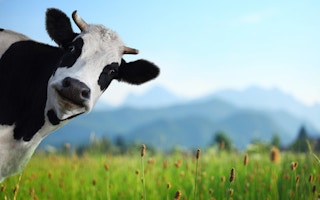New FAO estimates of greenhouse gas data show that emissions from agriculture, forestry and fisheries have nearly doubled over the past fifty years and could increase an additional 30 per cent by 2050, without greater efforts to reduce them.
This is the first time that FAO has released its own global estimates of greenhouse gas (GHG) emissions from agriculture, forestry and other land use (AFOLU), contributing to the Fifth Assessment Report of the Intergovernmental Panel on Climate Change (IPCC).
Agricultural emissions from crop and livestock production grew from 4.7 billion tonnes of carbon dioxide equivalents* (CO2 eq) in 2001 to over 5.3 billion tonnes in 2011, a 14 percent increase. The increase occurred mainly in developing countries, due to an expansion of total agricultural outputs.
Meanwhile, net GHG emissions due to land use change and deforestation registered a nearly 10 per cent decrease over the 2001-2010 period, averaging some 3 billion tonnes CO2 eq/yr over the decade. This was the result of reduced levels of deforestation and increases in the amount of atmospheric carbon being sequestered in many countries.
Averaged over the 2001-2010 period, agriculture, forestry and other land uses (AFOLU) emissions break down as follows:
5 billion tonnes CO2 eq/yr from crop and livestock production
4 billion tonnes CO2 eq/yr due to net forest conversion to other lands (a proxy for deforestation)
1 billion tonnes CO2 eq/yr from degraded peatlands
0.2 billion tonnes CO2 eq/yr by biomass fires
In addition to these emissions, some two billion tonnes CO2 eq/yr were removed from the atmosphere during the same time frame as a result of carbon sequestration in forest sinks.
“
The largest source of GHG emissions within agriculture is enteric fermentation - when methane is produced by livestock during digestion and released via belches - this accounted in 2011 for 39 per cent of the sector’s total GHG outputs
FAO’s data based on country reports show that while those emissions continue to increase, they are not growing as fast as emissions from fossil fuel use in other sectors, so the share of AFOLU out of total anthropogenic emissions is actually decreasing over time. (Read FAO’s report on the data)
Sources of agricultural emissions
The largest source of GHG emissions within agriculture is enteric fermentation - when methane is produced by livestock during digestion and released via belches - this accounted in 2011 for 39 per cent of the sector’s total GHG outputs. Emissions from enteric fermentation increased 11 per cent between 2001 and 2011.
Emissions generated during the application of synthetic fertilizers accounted for 14 percent of agricultural emissions (725 Mt CO2 eq.) in 2011, and are the fastest growing emissions source in agriculture, having increased some 37 percent since 2001.
Greenhouse gases resulting from biological processes in rice paddies that generate methane make up 10 per cent of total agricultural emissions, while the burning of savannahs accounts for 5 per cent.
In 2011, 45 per cent of agriculture-related GHG outputs occurred in Asia, followed by the Americas (25 per cent), Africa (15 per cent), Europe (11 per cent), and Oceania (4 per cent), according to FAO’s data. This regional distribution was fairly constant over the last decade. In 1990 however, Asia’s contribution to the global total (38 per cent) was smaller than at present, while Europe’s was much larger (21 per cent).
Figures for energy use
The new FAO data also provide a detailed view of emissions from energy use in the agriculture sector generated from traditional fuel sources, including electricity and fossil fuels burned to power agricultural machinery, irrigation pumps and fishing vessels.
These emissions exceeded 785 million tonnes of CO2 eq. in 2010, having increased by 75 per cent since 1990.
Better data means better responses
Designing responses will require detailed assessments of both emission data and mitigation options. For instance, FAO is already generating disaggregated assessments along supply chains and analyzing the effectiveness of comprehensive mitigation interventions in the livestock sector.
“FAO’s new data represent the most comprehensive source of information on agriculture’s contribution to global warming made to date,” said Francesco Tubiello of the Organization’s Climate, Energy and Tenure Division. “Up to now, information gaps have made it extremely difficult for scientists and policymakers to make strategic decisions regarding how to respond to climate change and has hampered efforts to mitigate agriculture’s emissions.”
‘’Data on emissions for AFOLU activities support member countries in better identifying their mitigation options and enable their farmers to take faster and more targeted climate-smart responses. This in turn improves their overall resilience and their food security. It also allows the countries to tap into international climate funding and accomplish their rural development goals. We also see much interest in capacity development on these topics at country level and respond to these needs through regional and country-level activities around the globe,” he added.
Contribution to IPCC reporting and FAO activities
Launched in 2012, the FAOSTAT emissions database has been for the first time a key source of GHG emissions data analysis of agriculture, forestry and other land use activities for the fifth IPPC Assessment Report, which is currently undergoing finalisation. Data updates and enhancements like those released today will be made annually.
The FAOSTAT emissions database was developed with financial support from the governments of Germany and Norway.










